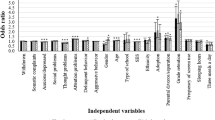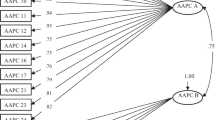Abstract
Psychopathology during adolescence has been associated with poor academic performance, low social well-being, and low social preference by peers at school. However, previous research has not accounted for comorbid psychopathology, informant-specific associations between psychopathology and functioning, and gender and age differences. This study addresses these limitations by examining adolescents’ psychopathology and functioning at school, reported by child, parent, teacher, and peers during primary and secondary school in a large Dutch longitudinal cohort study (N = 2230). Teacher reports of psychopathology, especially regarding attention problems and withdrawn/depressed problems, followed by parent reports regarding hyperactivity, were most strongly associated with academic performance. The same held for social preference which was associated with teacher and parent ratings of withdrawn/depressed problems and hyperactivity. In contrast, social well-being was best predicted by child reports (at primary school) of affective problems. In girls, the association between ADHD problems and poor academic performance was stronger than in boys and conduct problems were more often associated with poor school functioning in general. These findings can help identify adolescents at risk for poor functioning and design interventions that effectively reduce or prevent poor school functioning.
Similar content being viewed by others
References
Derdikman-Eiron R, Indredavik MS, Bratberg GH, Taraldsen G, Bakken IJ, Colton M (2011) Gender differences in subjective well-being, self-esteem and psychosocial functioning in adolescents with symptoms of anxiety and depression: findings from the Nord-Trondelag health study. Scand J Psychol 52:261–267
Glied S, Pine DS (2002) Consequences and correlates of adolescent depression. Arch Pediatr Adolesc Med 156:1009–1014
Moilanen KL, Shaw DS, Maxwell KL (2010) Developmental cascades: externalizing, internalizing, and academic competence from middle childhood to early adolescence. Dev Psychopathol 22:635–653
Frojd SA, Nissinen ES, Pelkonen MU, Marttunen MJ, Koivisto AM, Kaltiala-Heino R (2008) Depression and school performance in middle adolescent boys and girls. J Adolesc 31:485–498
Galera C, Melchior M, Chastang JF, Bouvard MP, Fombonne E (2009) Childhood and adolescent hyperactivity-inattention symptoms and academic achievement 8 years later: the GAZEL youth study. Psychol Med 39:1895–1906
Jaycox LH, Stein BD, Paddock S et al (2009) Impact of teen depression on academic, social, and physical functioning. Pediatric 124:596–605
Bongers IL, Koot HM, van der Ende J, Verhulst FC (2008) Predicting young adult social functioning from developmental trajectories of externalizing behaviour. Psychol Med 38:989–999
Riley AW, Ensminger ME, Green B, Kang M (1998) Social role functioning by adolescents with psychiatric disorders. J Am Acad Child Adolesc Psychiatry 37:620–628
Bagwell CL, Molina BSG, Pelham WE, Hoza B (2001) Attention-deficit hyperactivity disorder and problems in peer relations: predictions from childhood to adolescence. J Am Acad Child Adolesc Psychiatry 40:1285–1292
Laird RD, Jordan KY, Dodge KA, Pettit GS, Bates JE (2001) Peer rejection in childhood, involvement with antisocial peers in early adolescence, and the development of externalizing behavior problems. Dev Psychopathol 13:337–354
Leflot G, van Lier PAC, Verschueren K, Onghena P, Colpin H (2011) Transactional associations among teacher support, peer social preference, and child externalizing behavior: a four-wave longitudinal study. J Clin Child Adolesc Psychol 40:87–99
Kraemer HC, Measelle JR, Ablow JC, Essex MJ, Boyce WT, Kupfer DJ (2003) A new approach to integrating data from multiple informants in psychiatric assessment and research: mixing and matching contexts and perspectives. Am J Psychiatry 160:1566–1577
Noordhof A, Oldehinkel AJ, Verhulst FC, Ormel J (2008) Optimal use of multi-informant data on co-occurrence of internalizing and externalizing problems: the TRAILS study. Int J Methods Psychiatr Res 17:174–183
Angold A, Costello EJ, Erkanli A (1999) Comorbidity. J Child Psychol Psychiatry 40:57–87
Moffitt TE (1993) Adolescence-limited and life-course-persistent antisocial-behavior: a developmental taxonomy. Psychol Rev 100:674–701
Ormel J, Oldehinkel AJ, Sijtsema JJ, Van Oort F, Raven D, Veenstra R et al (2012) The TRacking Adolescents’ Individual Lives Survey (TRAILS): design, current status, and selected findings. J Am Acad Child Adolesc Psychiatry 51:1020–1036
Card D (1999) The causal effect of education on earnings. In: Ashenfelter O, Card D (eds) Handbook of labor economics, vol 3A. Elsevier, Amsterdam, pp 1801–1863
Deater-Deckard K (2001) Annotation: recent research examining the role of peer relationships in the development of psychopathology. J Child Psychol Psychiatry 42:565–579
Masten AS, Roisman GI, Long JD, Burt KB, Obradovic J, Riley JR et al (2005) Developmental cascades: linking academic achievement and externalizing and internalizing symptoms over 20 years. Dev Psychol 41:733–746
McCarty CA, Mason WA, Kosterman R, Hawkins JD, Lengua LJ, McCauley E (2008) Adolescent school failure predicts later depression among girls. J Adolesc Health 43:180–187
de Winter A, Oldehinkel AJ, Veenstra R, Brunnekreef JA, Verhulst FC, Ormel J (2005) Evaluation of non-response bias in mental health determinants and outcomes in a large sample of pre-adolescents. Eur J Epidemiol 20:173–181
Huisman M, Oldehinkel AJ, de Winter A et al (2008) Cohort profile: the Dutch ‘TRacking Adolescents’ Individual Lives’ Survey’; TRAILS. Int J Epidemiol 37:1227–1235
Dijkstra JK, Lindenberg S, Veenstra R (2007) Same-gender and cross-gender peer acceptance and peer rejection and their relation to bullying and helping among preadolescents: comparing predictions from gender-homophily and goal-framing approaches. Dev Psychol 43:1377–1389
Achenbach TM (1991) Manual for the youth self-report and 1991 profile. University of Vermont, Burlington, VT
Achenbach TM (1991) Manual for the child behavior checklist/04–18 and 1991 profile. University of Vermont, Burlington, VT
Achenbach TM, Dumenci L, Rescorla LA (2003) DSM-oriented and empirically based approaches to constructing scales from the same item pools. J Clin Child Adolesc Psychol 32:328–340
Ormel J, Lindenberg S, Steverink N, Vonkorff M (1997) Quality of life and social production functions: a framework for understanding health effects. Soc Sci Med 45:1051–1063
Nieboer A, Lindenberg S, Boomsma A, Van Bruggen AC (2005) Dimensions of well-being and their measurement: the SPF-IL Scale. Soc Indic Res 73:313–353
Veenstra R, Lindenberg S, Oldehinkel AJ, De Winter AF, Verhulst FC, Ormel J (2005) Bullying and victimization in elementary schools: a comparison of bullies, victims, bully/victims, and uninvolved preadolescents. Dev Psychol 41:672–682
Durbin J, Watson GS (1951) Testing for serial correlation in least squares regression. Biometrika 38:159–178
Daley D, Birchwood J (2010) ADHD and academic performance: why does ADHD impact on academic performance and what can be done to support ADHD children in the classroom? Child Care Health Dev 36:455–464
Gaub M, Carlson CL (1997) Gender differences in ADHD: a meta-analysis and critical review. J Am Acad Child Adolesc Psychiatry 36:1036–1045
Serra-Pinheiro MA, Mattos P, Regalla MA, de Souza I, Paixao C (2008) Inattention, hyperactivity, oppositional-defiant symptoms and school failure. Arq Neuropsiquiatr 66:828–831
Fernandez-Castillo A, Gutierrez-Rojas ME (2009) Selective attention, anxiety, depressive symptomatology and academic performance in adolescents. Electron J Res Educ Psychol 7:49–76
Shafran R, Mansell W (2001) Perfectionism and psychopathology: a review of research and treatment. Clin Psychol Rev 21:879–906
Borelli JL, Prinstein MJ (2006) Reciprocal, longitudinal associations among adolescents’ negative feedback-seeking, depressive symptoms, and peer relations. J Abnorm Child Psychol 34:159–169
Cicchetti D, Schneider-Rosen K (1986) An organizational approach to childhood depression. In: Read P (ed) Depression in young people: clinical and developmental perspectives. Guildford Press, New York, pp 71–134
Patterson GR, Yoerger K (1993) Developmental models for delinquent behaviour. In: Hodgins S (ed) Mental disorders and crime. Sage, Newbury Park, CA
Bukowski WM, Sippola LK, Newcomb AF (2000) Variations in patterns of attraction to same- and other-sex peers during early adolescence. Dev Psychol 36:147–154
Allen JP, Weissberg RP, Hawkins JA (1989) The relation between values and social competence in early adolescence. Dev Psychol 25:458–464
Frankel F, Feinberg D (2002) Social problems associated with ADHD vs. ODD in children referred for friendship problems. Child Psychiatry Hum Dev 33:125–146
Pardini DA, Fite PJ (2010) Symptoms of conduct disorder, oppositional defiant disorder, attention-deficit/hyperactivity disorder, and callous-unemotional traits as unique predictors of psychosocial maladjustment in boys: advancing an evidence base for DSM-V. J Am Acad Child Adolesc Psychiatry 49:1134–1144
Acknowledgments
This research is part of the TRacking Adolescents’ Individual Lives Survey (TRAILS). Participating centers of TRAILS include various departments of the University Medical Center and University of Groningen, the Erasmus University Medical Center Rotterdam, the University of Utrecht, the Radboud Medical Center Nijmegen, and the Parnassia Bavo group, all in the Netherlands. TRAILS has been financially supported by various grants from the Netherlands Organization for Scientific Research (NWO), ZonMW, GB-MaGW, the Dutch Ministry of Justice, the European Science Foundation, BBMRI-NL, the participating universities, and Accare Center for Child and Adolescent Psychiatry. We are grateful to all adolescents, their parents, and teachers who participated in this research, and to everyone who worked on this project and made it possible.
Author information
Authors and Affiliations
Corresponding author
Appendices
Appendix 1: Original Items of the Teachers Checklist of Psychopathology
Items are translated from Dutch into English
-
1.
Withdrawn behavior
Rather be alone; withdrawn; doesn’t get along; secretive; won’t talk; lacks energy; blank glance; sulks.
-
2.
Anxious/depressed
Feels lonely; cries a lot; must be perfect; fears mistakes; anxious to please; feels unloved; feels worthless; nervous; fears; feels too guilty; quickly embarrassed; fearful; hurt when criticized; unhappy; sad; worries.
-
3.
Thought problems
Can’t get mind off thoughts; scared of particular animals, situations or places; repeats acts; hears things; sees things; strange behavior; strange ideas; picks skin.
-
4.
Attention problems
Fails to finish; can’t concentrate; confused; daydreams; difficulty learning; difficulty with directions; inattentive; easily distracted; underachieves; fails to carry out tasks.
-
5.
Activity/impulsivity
Odd noises; can’t sit still; over-active; fidgets; irresponsive; impulsive; inconsiderate; messy work.
-
6.
Aggressive behavior
Argues a lot; defiant; brags; mean; provocative; demands attention; destroys own or others’ things; disobedient; disturbs other students; causes turbulence at school; jealous; gets in fights; attacks people; screams a lot; explosive or suspicious; easily frustrated; stubborn, sullen; mood changes; teases a lot; temper; threatens others.
-
7.
Rule-breaking behavior
Lacks guilt; bad friends; lies, cheats; prefers older kids; steals; swears; too late at school; truant; uses tobacco.
Appendix 2: Original Items of the Teacher Questionnaire: Academic Performance Scale
Items are translated from Dutch into English
-
1.
Student has a good work pace
-
2.
Student shows effort
-
3.
Student does not perform in accordance with own level (reversed item)
-
4.
How do you rate the overall performance of the student?*
-
5.
Current results regarding Dutch language
-
6.
Current results regarding foreign languages?*
-
7.
Current results regarding maths
-
8.
Current results regarding geography and history?*
-
9.
Current results regarding physics, chemistry, and biology?*
* Only measured at secondary school (T2)
Appendix 3: Original Items from the Social Production Function Questionnaire: Social Well-Being Scale
-
1.
Most classmates like doing something together with me.
-
2.
Most classmates help me if needed.
-
3.
Most classmates consider my feelings.
-
4.
Most classmates like being with me.
-
5.
Most classmates think I behave well.
-
6.
Most classmates like to get my help.
-
7.
Most classmates I can truly trust.
-
8.
Most classmates appreciate me like I am.
-
9.
Most classmates look up to me.*
-
10.
Most classmates would like to be somewhat like me.*
-
11.
Most classmates think I am one of the nicest students in class.*
* Only measured at secondary school (T2)
Rights and permissions
About this article
Cite this article
Sijtsema, J.J., Verboom, C.E., Penninx, B.W.J.H. et al. Psychopathology and Academic Performance, Social Well-Being, and Social Preference at School: The TRAILS Study. Child Psychiatry Hum Dev 45, 273–284 (2014). https://doi.org/10.1007/s10578-013-0399-1
Published:
Issue Date:
DOI: https://doi.org/10.1007/s10578-013-0399-1




